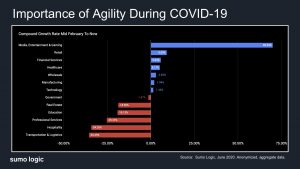Why Digital Transformation relies on Continuous Intelligence
This is a guest blogpost by Bruno Kurtic, co-founder and vice president of strategy and solutions, Sumo Logic
I recently had a conversation with someone who tried to argue that digital transformation is just another fad that tech companies like to talk about. Not only did I vehemently disagree, but it made me realize that many people still do not realize the depth of change occurring in business today as a result of digital transformation.
It is true that the idea of businesses “going digital” has been around for 25 years, beginning with the World Wide Web (WWW) and the shift to e-business in the 1990s. However, digital transformation takes it to a whole new level. The change is so dramatic that I see it as the fourth stage of the industrial revolution: 1) the steam engine; 2) automated production line; 3) introduction of computing power to manufacturing and supply chains; and now, 4) the digital experience industry. Secondly, we are nowhere near being done, with probably a couple of decades to go. This is similar to Ray Amara’s quote, in that “We tend to overestimate the effect of a technology in the short run and underestimate the effect in the long run.”
What makes this change so fundamental is that software is no longer the realm of traditional software technology companies, like Microsoft or Oracle. Businesses across all industries are becoming software companies and run their operations accordingly. That’s because digital services — the foundation of digital experiences — is the new gold rush for market growth in every industry vertical. Building those relevant, differentiated services can no longer be based on software you can buy off-the-shelf, as this makes you the same as everyone else. These custom applications either are your product, or power your physical products, or are a way of delivering your products in a new and differentiated way.
These applications are finely tuned to your business model, and require a completely new set of processes, practices and intelligence to ensure their relevance, viability and success. In order for an enterprise to become a successful and competitive digital business, it must go through several structural, architectural, and process changes:
- The software lifecycle: The shift from waterfall multi-year software development cycles to agile development in which DevOps or DevSecOps teams work more closely together, pushing code to production environments dozens of times a day.
- Computing environments: The shift from traditional private and hybrid data centers (on-prem + private cloud) to public cloud to increase business flexibility and agility.
- Application architectures: The shift from tightly coupled software/hardware applications to loosely-coupled microservices architectures. This is made easier by the growing use of containers, and orchestration software, like Kubernetes, to manage underlying infrastructure resources to execute microservices.
Combined, all three of these shifts can give companies unprecedented agility and flexibility to respond to new opportunities and growth. However, one consequence is the need for real-time intelligence to address the development, reliability, scalability, and security of these digital services because their underlying infrastructure has now become automated, virtualized, ephemeral and highly complex. To illustrate: instead of managing a few hundred servers to drive their off-the-shelf or ERP applications, today’s digital service applications run on tens to hundreds of thousands of containers. More than 50% of these containers have a lifespan of less than 30 minutes. So, having real-time intelligence on them to know what they are doing is essential and it requires an analytics system that can keep track and analyze orders of magnitude more data streams.
These trends are what is giving rise to Continuous Intelligence– an analytics approach for digital services. Continuous Intelligence transforms streaming machine data from all infrastructure, compute nodes, devices, and applications that make up digital services into real-time analytics to monitor, troubleshoot and secure those digital services as well as to empower business teams with insights needed to improve business operations in real-time. Old analytics tools built for OTS and ERP apps won’t cut it for this new digital business running in the cloud, agile, microservices-based world.
Two recent data points point to the growing traction of continuous intelligence as the analytics approach for digital transformation: the COVID-19 pandemic and a recent Sumo Logic survey.

The chart above is from data we track in our Continuous Intelligence Platform. It shows how various industries have been impacted by Covid-19, and which ones are thriving. However, here’s what is less obvious: in retail, for example, in the last three months, the growth rate of our subset of retailers is three to four times greater than what was projected by retail industry analysts for the full year 2020.
This means retailers who have invested in digital transformation previously are gaining a significant advantage over those who have not – an advantage I believe will remain post Covid-19, because these new consumer shopping habits occurring online will not go away — they will be the new norm. This speaks to a business discontinuity that all industries should take note: digital transformation is real rather than a fad, and those that invest now will pull away in market share and digital customer acquisition faster than those who don’t.
Secondly, a recent survey conducted by independent research firm, King Brown Partners, revealed that continuous intelligence is also becoming more important for enterprises as more leaders agree on its business value:
- 88% of C-suite executives surveyed said they believe their company will benefit from continuous intelligence
- 76% indicated they are likely to employ continuous intelligence within the next 12 months
- 74% believe continuous intelligence will help drive companies’ speed and agility
- 62% believe continuous intelligence is a new approach to data that many companies will need to embrace as they become more software-driven to drive revenue.
I encourage you to check out the full report here.



